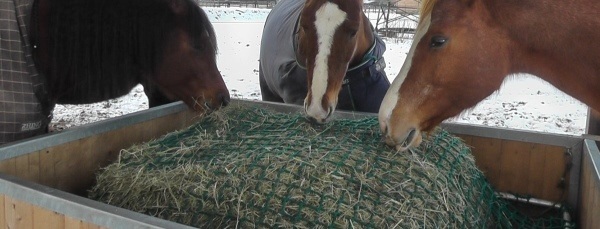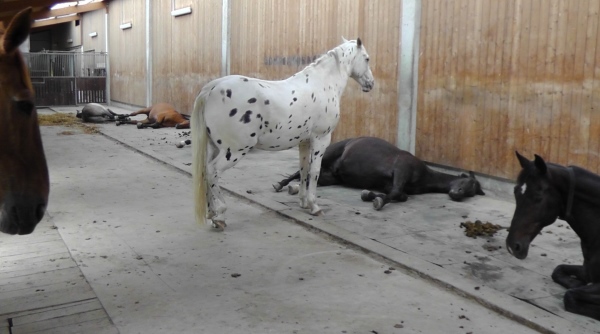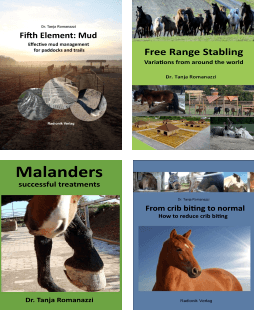Is free range stabling a suitable option for my horse?
I’ve often been asked this question and the simple answer is:
Free range stabling is a suitable option for any horse that can walk without going lame.
There is no need to worry about a formerly stabled horse getting too cold (as long as you don’t move it outside from a warm stall in mid-winter). Horses are very good at adapting to changes in temperature (especially if you don’t hinder them by using blankets).
But unfortunately, the real question is not whether free range stabling is a suitable option for your horse in general, but rather whether X free range stable is a suitable option for Y horse. And this question is a lot harder to answer, as it depends on a number of circumstances. And sadly enough, an unsuitable free range stable often leads to more stress than a good stall. The following factors should therefore be taken into consideration:
Is the horse a good fit with the herd?
The best way to answer to this question is to provide a list of all the unsuitable combinations:
Old or infirm horses will frequently not be properly accepted into the herd (they would increase the overall risk to the herd in the wild, as they are no longer able to flee quickly enough). This makes integration difficult and the horses tend to live at the margins of the herd. These horses do a lot better if kept with only 1-3 other horses of a similar age or degree of infirmity.
Riggish geldings in mixed sex groups are frequently problematic. They mount the mares and sometimes take their protective and defensive duties too far. This leads not only to trouble with the mares’ owners and problems when integrating new horses, it also generally prevents the gelding in question from settling down (as he has to constantly stay on his guard). These geldings do better when stabled in groups with other geldings.

Very low-ranking horses are another group that warrants careful consideration. Finding a herd with similar horses is not a good solution. Insecure horses in particular need a group with a strong leader in order to feel safe. Mini-herds, consisting of 2-3 horses, can be an especial problem, if none of the horses wishes to take on a leadership role. The horses do not feel safe, they tend not to lie down and are reluctant to separate (if you want to ride them, for example).
Are the hay feeding methods suitable for my horse?
Free-range stabling should involve 24/7 hay feeding and ideally, hay feeds should be freely available at any time. How well this works generally depends on the hay quality. As stable owners are frequently obliged to rely on high-sugar hay, many free range stablers use different solutions for regulating portion size. You will have to decide for yourself whether the solution in question is actually the best one for your horse. As a basic requirement, the hay quality should be as good as possible (regarding mould and sugar content).
Depending on the hay’s sugar content and your horse’s needs, you will have to assess whether the feed sizes are right for your horse. A look at the other horses can be helpful in this respect. If they all look a little chubby and if your own horse already has problems with its weight or metabolism, then this is not the right choice of free range stable. But if the other horses are all around the lower limit and if your own horse needs enormous amounts of hay to look reasonably well-rounded, then this is just as unlikely to be a good fit.

A third point is the feeding method. If I have a very low-ranking horse, it is especially important for there to be enough hay feeding spots and for all the horses to be able to feed in peace. For example, if there are only two automatic hay feeders for 10 horses, it is fairly safe to assume that hay feeding will not be stress-free for the low-ranking horses in particular.
Can my horse cope with the grazing times?
Sadly, there is an increasing number of horses with metabolic problems who should either not be allowed out to pasture or else do so only within limits. Again, the resources offered by the free range stable should be a good fit with your horse’s needs. In my experience, there is no need to categorically deny a problematic horse access to grazing. How much grass a horse with metabolic issues can cope with will depend largely on pasture quality and grazing management. If the areas available are sufficiently large to permit regular alteration so that the horses have access to tall grass, then even former laminitis sufferers can enjoy grazing from time to time. After all, we should not forget that hay itself is simply dried grass. However, if the vegetation is uniform and the areas are constantly overgrazed, this topic will have to be viewed more critically.
Can my horse lie down in a free range stable?
One problem that frequently goes unnoticed in free range stables is that the lower ranking horses do not lie down enough. It is therefore important to make sure that the rest areas are sufficiently large (at least 8 m² per full-sized horse, 10 m² being preferable), that they are cut to suit the horses’ needs (for example, no long corridors with only one entrance at the shorter side) and that the bedding is “right”.

It is especially difficult to find a blanket solution to the last point. In some herds, for instance, rubber mats work very well, while other herds simply won’t lie down on them. As a general rule, horses prefer to lie on soft bedding (straw, sawdust, etc.) and other materials may require a familiarisation period. Studies on this topic (Zeitler-Feicht) have shown that horses who were used to rubber mats accepted these nearly as well as sawdust beddings, while horses who were unfamiliar with them clearly preferred the sawdust. However, familiarisation does not generally occur on its own. For example, you may have to cover the mats with a layer of sawdust at first, gradually reducing the layer over time.
Are the other conditions a good fit, not just for my horse, but for me as well?
Both the horse and its owner should be happy with the stable. Ever if your horse is fine in principal, it’s no good if you yourself are uncomfortable every time you visit the stable, for instance because you don’t get on with the rest of the community or you can’t agree with the stable owner on anything. If you really want to take part in competitive sports, then you will need an indoor riding hall for the winter, or a least an outdoor enclosure that can be used for riding. If hacking is your “be all and end all”, then you will need at least halfway appropriate hacking grounds. You should therefore only accept those compromises that you are sure you will be able to live with in the long term.

